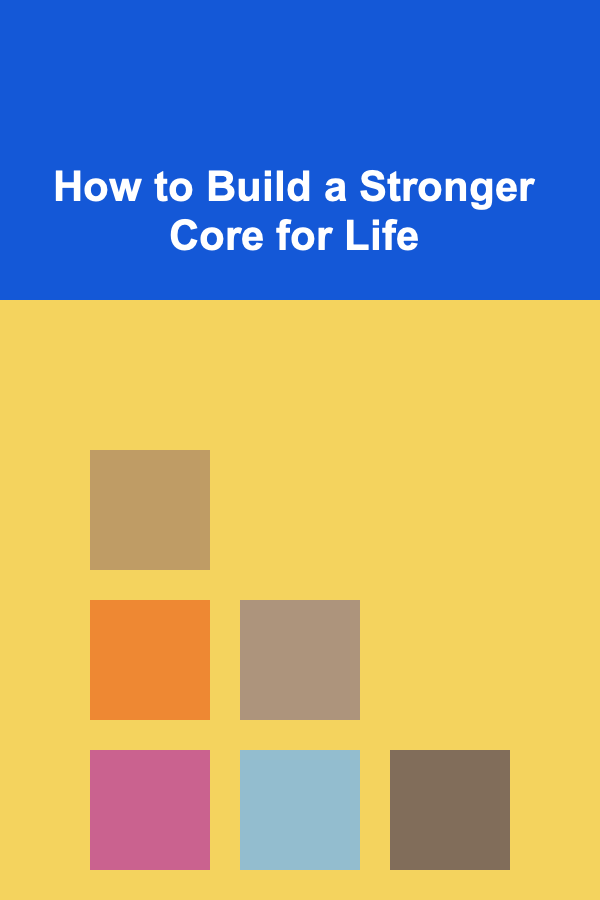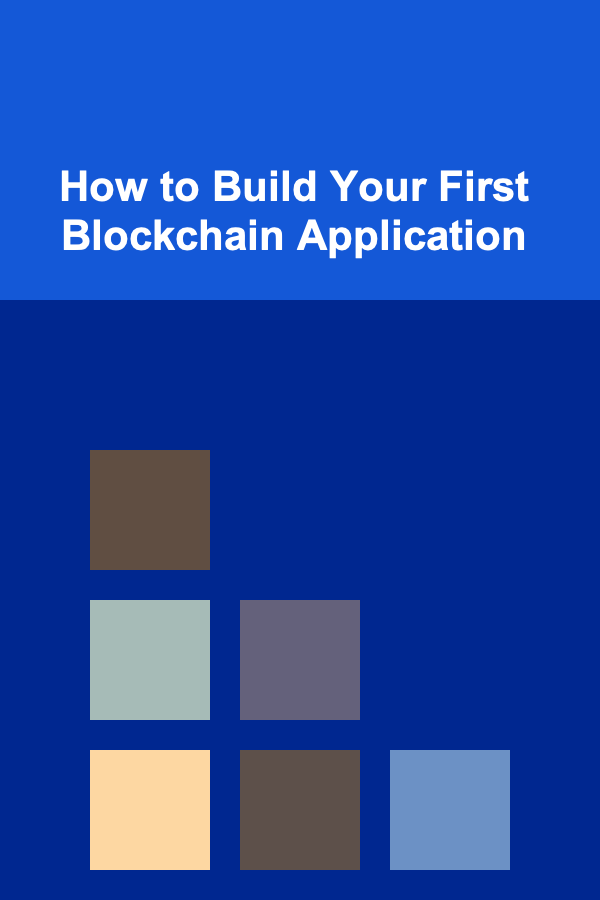
How to Build a Stronger Core for Life
ebook include PDF & Audio bundle (Micro Guide)
$12.99$8.99
Limited Time Offer! Order within the next:

A strong core is often thought of as a foundation for physical strength, but the truth is, it's much more than that. While a well-developed core is essential for improving posture, balance, and athletic performance, it also plays a significant role in your overall well-being and mental fortitude. A stronger core can lead to better health, less injury, and even mental clarity, ultimately improving the quality of your life.
Building a stronger core requires more than just doing crunches or sit-ups. It involves a holistic approach, targeting the muscles in your abdomen, back, pelvis, and hips, as well as developing mental resilience and emotional fortitude. In this article, we will explore how to build a stronger core for life, both physically and mentally, by incorporating exercise, nutrition, and mindset strategies into your daily routine.
Understanding the Core
When people talk about strengthening their core, they are generally referring to the muscles that make up the torso , including those in the abdomen , lower back , hips , and pelvis. These muscles are critical because they serve as the stabilizers of the body, allowing you to maintain posture and balance, and to transfer power from your lower body to your upper body (and vice versa).
Key Muscles of the Core
- Rectus Abdominis: Often referred to as the "six-pack" muscles, they are located along the front of your abdomen.
- Obliques: These muscles are located on either side of your abdomen and are responsible for rotating and bending your torso.
- Transverse Abdominis: This deep muscle wraps around your torso like a corset and is vital for stabilizing the spine.
- Erector Spinae: These muscles run along the spine and are essential for back support and posture.
- Multifidus: Located along the spine, these muscles provide stability and support during movement.
- Pelvic Floor Muscles: These muscles support the organs in the pelvic area and are essential for bladder and bowel control.
Understanding the importance of these muscles helps in appreciating why a strong core is essential not only for physical health but also for emotional resilience, posture, and stability in life.
The Physical Benefits of a Stronger Core
Building a stronger core isn't just about aesthetics or looking good. The benefits of a strong core extend far beyond appearance and can positively impact many aspects of daily life.
Improved Posture
One of the most immediate benefits of strengthening your core is better posture. A weak core can lead to slouching, a rounded back, and poor alignment, all of which can contribute to discomfort and long-term back pain. When your core is strong, your spine is supported and naturally aligned, which can help prevent and alleviate back pain.
Enhanced Balance and Stability
The core is directly responsible for maintaining balance and stability. Whether you're standing, walking, or running, a strong core provides the necessary support to keep you upright and in control. This is especially important as you age, as maintaining balance can reduce the risk of falls and injuries.
Better Athletic Performance
A strong core is essential for athletes in virtually every sport. It allows for better force transfer between the upper and lower body, which can improve strength, speed, and endurance. Whether you're running, cycling, swimming, or lifting weights, a strong core ensures that you can execute movements more efficiently and effectively.
Injury Prevention
By strengthening the core muscles, you reduce the risk of injuries. A weak core often leads to compensations elsewhere in the body, such as the lower back or knees, which can result in strain and injury. A well-conditioned core helps to maintain proper body mechanics and movement patterns, reducing the risk of both acute and chronic injuries.
Spinal Health and Pain Relief
The core plays a key role in supporting the spine. Weak core muscles can lead to an increase in pressure on the spine, leading to discomfort and pain. A strong core helps stabilize the spine and can alleviate or prevent conditions such as herniated discs, sciatica, and other lower back problems.
Better Breathing and Digestion
The diaphragm, which plays a crucial role in breathing, is part of your core. Strengthening your core muscles can improve your breathing patterns and increase lung capacity. Additionally, the core muscles are linked to the digestive system, and strengthening them may help improve digestion and reduce bloating and discomfort.
Mental and Emotional Resilience: The Core of Your Mindset
Building a stronger core is not just about the physical muscles in your body. The strength of your core also extends to your mental and emotional resilience. Much like your physical core, a strong mindset provides stability, focus, and the ability to handle challenges in life.
The Power of Grit and Mental Toughness
Mental resilience is a critical component of building a stronger core. Mental toughness or "grit" is the ability to persevere through challenges, setbacks, and difficult times without giving up. It's the ability to keep moving forward, even when things seem impossible.
Developing mental resilience involves:
- Building Patience: Patience allows you to endure challenges without losing your resolve.
- Embracing Discomfort: True growth often happens outside of your comfort zone. Learning to tolerate discomfort builds mental strength.
- Staying Focused: Mental resilience is built by maintaining focus on your goals, even in the face of distractions.
Emotional Regulation
A strong emotional core helps you manage your feelings and reactions, particularly in stressful or challenging situations. It's about understanding your emotions, taking control over them, and not letting them dictate your actions. Emotional resilience can help you handle disappointments, conflicts, and unexpected changes with grace and composure.
Strategies for developing emotional resilience include:
- Mindfulness and Self-Awareness: Becoming more aware of your emotions and reactions can help you manage them effectively.
- Developing Positive Thinking: Cultivating a positive mindset can help you reframe challenges as opportunities rather than obstacles.
- Building a Support System: Surrounding yourself with a supportive community can help you navigate tough times.
Adaptability and Flexibility
Life is constantly changing, and the ability to adapt to new circumstances is essential for maintaining a strong core. Building adaptability means being open to change and viewing challenges as opportunities for growth. This flexibility allows you to bounce back from setbacks and continue moving forward, even when things don't go as planned.
Steps to Build a Stronger Core
Building a stronger core, both physically and mentally, requires a consistent, deliberate approach. Here are the key steps you can take to strengthen your core for life.
Physical Core Strengthening Exercises
Incorporating core-strengthening exercises into your routine is essential for building a strong physical foundation. Below are some exercises that target various parts of the core:
- Planks: A full-body exercise that engages the entire core. Hold the position for 30 seconds to a minute, focusing on keeping the body in a straight line.
- Russian Twists: This exercise targets the obliques. Sit on the floor with your feet elevated and rotate your torso from side to side while holding a weight.
- Leg Raises: Lie on your back and raise your legs while keeping your core tight. This exercise targets the lower part of your abdomen.
- Bird Dogs: While on all fours, extend one arm and the opposite leg, maintaining stability through your core. This helps improve balance and strengthens the lower back.
- Dead Bugs: Lie on your back with your arms extended and knees bent. Slowly lower one arm and the opposite leg, engaging your core to maintain stability.
Incorporating Functional Movements
Functional movements like squats, lunges, and deadlifts are great for developing core strength, as they engage multiple muscle groups, including the core. By including functional exercises in your routine, you will build both strength and stability.
Breathwork and Relaxation Techniques
Breathing exercises and relaxation techniques, such as yoga and meditation, can help improve the mind-body connection and enhance core stability. Focused breathing exercises can activate the diaphragm and engage the core muscles, promoting both physical and mental resilience.
Mental and Emotional Strengthening Practices
- Mindfulness Meditation: Practicing mindfulness helps to cultivate awareness and emotional regulation, which are essential for building a resilient emotional core.
- Cognitive Behavioral Techniques: Use strategies like positive self-talk and reframing to build mental toughness and resilience.
- Goal Setting: Set both short-term and long-term goals. Achieving them will build self-confidence and a sense of accomplishment.
Maintaining a Healthy Lifestyle
A balanced diet, regular exercise, sufficient sleep, and stress management are foundational to both physical and mental strength. A strong core requires a healthy body, and a healthy body thrives on proper nutrition, hydration, and rest.
Conclusion
Building a stronger core for life involves more than just physical exercise. It requires a holistic approach that targets both the body and the mind. By incorporating physical core-strengthening exercises, mental toughness practices, and emotional resilience strategies, you can create a foundation of strength that will support you through life's challenges.
A strong core enables you to move through life with confidence, balance, and resilience. Whether you are striving to improve your posture, athletic performance, or mental fortitude, strengthening your core is a critical investment in your long-term well-being. By taking the steps outlined in this article, you can build a stronger core that supports not only your physical health but also your emotional and mental well-being.

How to Transform Staging My House into a Compelling Selling Point
Read More
How To Use Astrophotography Software for Processing
Read More
The Art of Legal Assistance: Techniques for Streamlining Legal Research and Documentation
Read More
How to Practice Digital Detox for Mental Clarity
Read More
How to Build Your First Blockchain Application
Read More
How to Conduct Informational Interviews Effectively: A Comprehensive Guide
Read MoreOther Products

How to Transform Staging My House into a Compelling Selling Point
Read More
How To Use Astrophotography Software for Processing
Read More
The Art of Legal Assistance: Techniques for Streamlining Legal Research and Documentation
Read More
How to Practice Digital Detox for Mental Clarity
Read More
How to Build Your First Blockchain Application
Read More